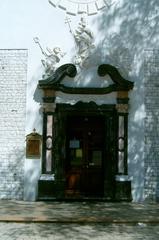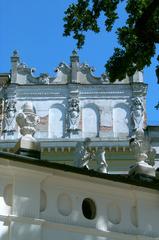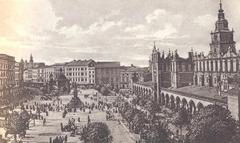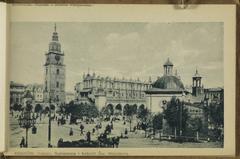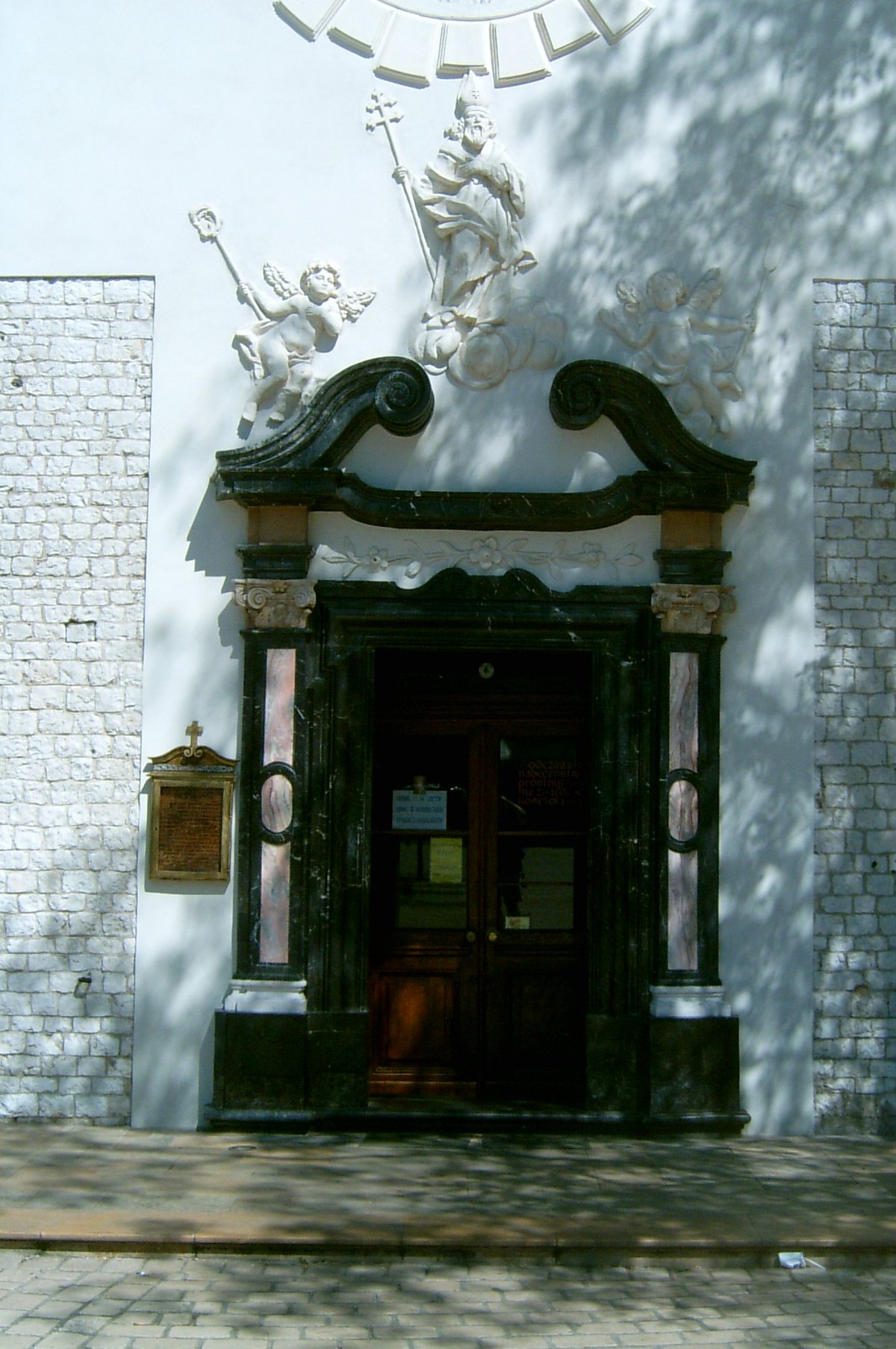
St. Adalbert’s Church Kraków, Poland: Visiting Hours, Tickets, and Complete History Guide
Date: 14/06/2025
St. Adalbert’s Church (Kościół św. Wojciecha) stands as a silent witness to the centuries-long history of Kraków, Poland. Nestled on the southern edge of the Main Market Square, it is one of the country’s oldest stone churches and a unique testament to the city’s spiritual, cultural, and architectural evolution. This comprehensive guide provides in-depth information on the church’s history, visitor experience, practical details, and tips to ensure an enriching visit.
Table of Contents
- Introduction
- Historical Overview
- Architectural Features
- Visitor Information
- Cultural and Religious Significance
- Events and Special Occasions
- FAQ
- References and Further Reading
Introduction
Located in the heart of Kraków’s UNESCO-listed Old Town, St. Adalbert’s Church is a compact yet historically significant monument. Its origins trace back to the dawn of Polish Christianity, and its walls bear the marks of Romanesque, Gothic, and Baroque transformations. For travelers, history enthusiasts, and architecture lovers, this church offers a profound glimpse into the city’s layered past and vibrant present.
Historical Overview
Early Origins and Foundation
The roots of St. Adalbert’s Church go back to the late 10th or early 11th century, shortly after the Christianization of Poland. Archaeological research indicates that the site originally hosted a wooden church commemorating the missionary work of St. Adalbert (Św. Wojciech), who preached in Kraków before his martyrdom in 997 AD (Spotting History). By the late 11th century, this structure was replaced by a permanent Romanesque stone building, parts of which are still visible today (krakow.wiki, en.wikipedia.org).
The church’s dedication to St. Adalbert highlights its foundational role in the Christianization of Poland and its importance as a spiritual and community center throughout the medieval period (Adequate Travel).
Architectural Evolution
- Romanesque Foundations: The original Romanesque structure featured limestone cobble walls and a southern portal—among the oldest architectural features in Kraków’s Main Market Square (krakow.travel).
- Medieval Modifications: Over centuries, the church saw Gothic influences, particularly in window and arch designs, though many of these features were later masked by Baroque renovations (medievalheritage.eu).
- Baroque Transformation: In the 17th century, the church underwent significant remodeling. The addition of a Baroque dome, raised walls, plastered facades, and ornate interior decorations transformed its silhouette on the Main Square (krakow.wiki, its-poland.com).
- Preservation: Ongoing restoration efforts have ensured that the building’s architectural layers—Romanesque, Gothic, Baroque—remain visible to visitors today (medievalheritage.eu).
Architectural Features
- Asymmetrical Placement: The church’s slightly skewed orientation predates the layout of the Main Market Square, emphasizing its ancient origins (karnet.krakowculture.pl).
- Baroque Dome: The elegant green dome, visible from across the square, is a hallmark of the church’s 17th-century transformation.
- Romanesque Portal: The south portal is one of Kraków’s rare surviving Romanesque features.
- Sunken Floor: Due to centuries of urban development, the church floor sits nearly two meters below the current street level—a unique architectural curiosity.
- Intimate Interior: The single nave is adorned with Baroque stucco, gilded altars, and 17th-18th-century paintings. An 18th-century organ is used for occasional concerts (krakow.wiki).
Crypt Museum
Beneath the church, the crypt houses a museum managed by the Archaeological Museum of Kraków. This exhibition, titled “The History of the Kraków Market,” displays medieval foundations, ancient tombstones, and artifacts illuminating the evolution of both the church and the Main Square (ma.krakow.pl).
Visitor Information
Location and Accessibility
- Address: Plac Mariacki 3, 31-042 Kraków, Poland
- Setting: On the southern side of Main Market Square (Rynek Główny), easily accessible from all directions.
- Transport: Nearest tram stops: “Plac Wszystkich Świętych” and “Teatr Bagatela” (10-minute walk). Kraków Główny railway station is about 1 km away (Kraków Info).
Visiting Hours and Tickets
-
Church Opening Hours:
- Monday–Saturday: 10:00 AM – 4:00 PM
- Sunday: 1:00 PM – 4:00 PM
- Closed during some services or special events; check current details at official parish website.
-
Crypt Museum:
- Open May–September, Monday–Saturday, 10:00–16:00.
- Closed on Sundays and during church services.
-
Admission:
- Entry to the main church is free (donations welcome).
- Crypt museum entry: 5–10 PLN; free on Tuesdays.
Guided Tours and Museum
- Tours:
- While the church does not offer regular guided tours, many Kraków Old Town walking tours include a stop at St. Adalbert’s (Free Walking Tour Kraków).
- The crypt museum displays information in Polish and English.
- Accessibility:
- The ground-level entrance is accessible, but the crypt is reachable only by stairs and is not wheelchair accessible.
Visitor Tips
- Dress Code: Modest attire (shoulders and knees covered) is required.
- Photography: Permitted outside of services; no flash or tripods. Professional photography requires prior arrangement (Parish Contact).
- Best Times to Visit: Early weekday mornings or late afternoons for a quieter experience.
- Facilities: No restrooms inside; public facilities are available nearby in the Main Square.
- Nearby Attractions: St. Mary’s Basilica, Cloth Hall (Sukiennice), and Wawel Castle are all within walking distance.
Cultural and Religious Significance
St. Adalbert’s Church has always been more than an architectural gem. It served as a chapel for merchants and travelers, a hub for local guilds, and a refuge for reflection in the city’s bustling heart. Its continued use for worship, daily Mass, and special ceremonies reinforces its role as a living spiritual center. The church is also a symbol of Kraków’s layered Christian heritage and is recognized as a protected monument within the UNESCO-listed Old Town (Adequate Travel).
Occasionally, the church hosts classical music recitals, leveraging its historic organs and intimate acoustics (krakow.wiki).
Events and Special Occasions
- Religious Services: Daily Mass and confessions are offered. The church is especially active on the feast day of St. Adalbert (April 23).
- Cultural Events: Concerts and lectures are occasionally scheduled, particularly during summer festivals.
- Special Visits: For group or educational visits, contact the parish office in advance.
FAQ
Q: What are the opening hours for St. Adalbert’s Church?
A: Monday–Saturday: 10:00 AM – 4:00 PM; Sunday: 1:00 PM – 4:00 PM. Hours may vary for services and holidays.
Q: Is there an entry fee?
A: Entry to the main church is free; the crypt museum charges 5–10 PLN.
Q: Are guided tours available?
A: The church is included in many city walking tours, but does not offer regular in-house tours.
Q: Is the church wheelchair accessible?
A: The main entrance is accessible, but the crypt is not due to stairs.
Q: Can I take photos inside?
A: Yes, except during Mass or with professional equipment (permission required).
References and Further Reading
- Spotting History – Church of St. Adalbert
- Adequate Travel – St. Adalbert’s Church
- Kraków Wiki – St. Adalbert Church
- Medieval Heritage – St. Adalbert’s Church
- Kraków Info – St. Adalbert’s Church
- Kraków Travel – St. Adalbert’s Church
- Culture.pl – St. Adalbert’s Church
- Official Parish Website
- Archaeological Museum Kraków – St. Adalbert’s Church Tour
- Karnet Kraków Culture – St. Adalbert’s Church
For the most up-to-date information, visit the Archaeological Museum of Kraków and the parish’s official website.
Plan your visit, explore Kraków’s cultural treasures, and make the most of your journey with the Audiala app. For more travel tips and updates, follow us on Facebook and Instagram.
